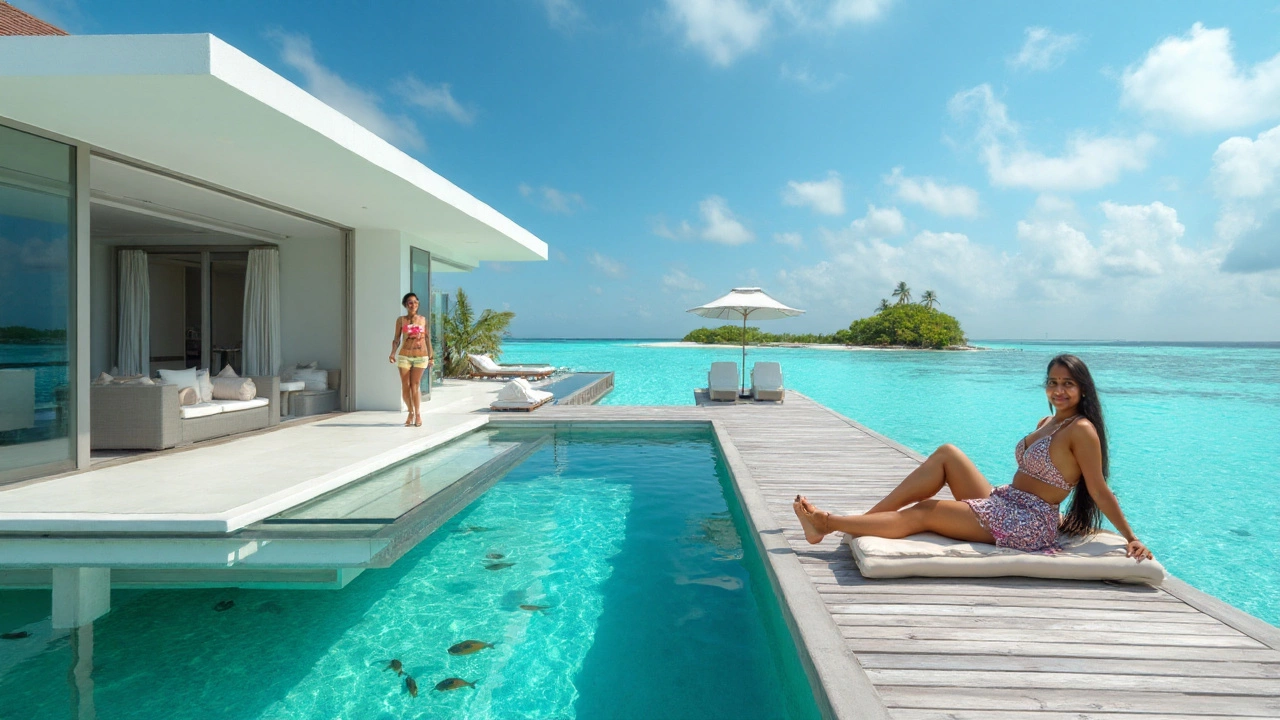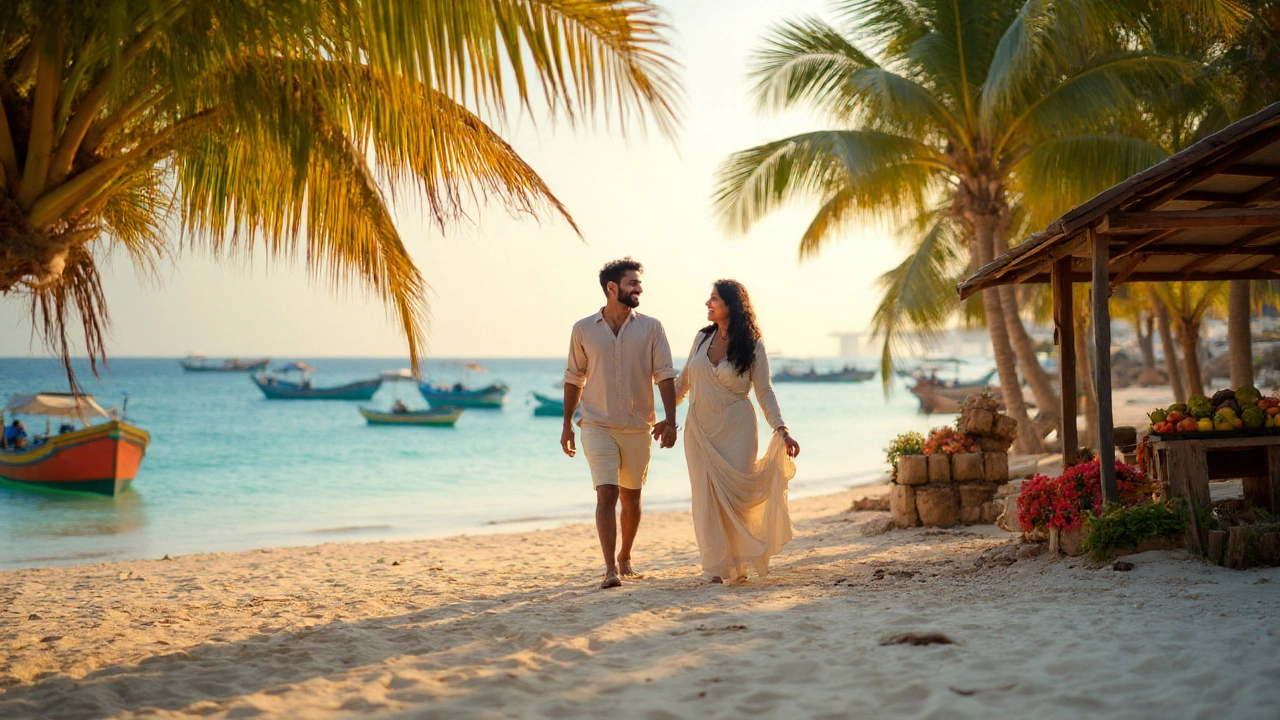Imagine standing on a bone-white beach, the water in front of you shining a color so bright it almost looks lit up from below. That moment of “where in the world am I?” could hit you either in Lakshadweep or the Maldives. Both promise coral reefs, sparkling lagoons, and laid-back island days. But which gives you more bang for your buck, adventure for your soul, or Insta-brag for your friends back home? Most people see the Maldives as the gold standard of tropical escapes, but Lakshadweep is gaining fans who argue it’s just as dreamy (if not more) — and often for a fraction of the cost. Let’s peel back the layers of turquoise water and find out what really sets these two apart.
Where They Shine: Geography, Nature, and The Vibe
Ever noticed how every photo of the Maldives seems impossibly blue and empty, dotted with thatched-roof overwater villas? That’s not just Instagram’s filters. Maldives is a country made up of 1,192 coral islands strewn across 26 atolls in the Indian Ocean, southwest of Sri Lanka. Those iconic villas, private island resorts, and endless blue horizon really are the signature here.
Lakshadweep, floating off the coast of Kerala, beats with its own rhythm. It has only 36 islands, out of which just 10 are inhabited, and fewer still are open to tourists. Of all those, Agatti, Bangaram, Kavaratti, Kalpeni, and Minicoy make the shortlist for visitors dreaming of sand between their toes. Each is fringed with swaying palms, shallow lagoons, and coral reefs packed with neon-colored fish and sea turtles. Lakshadweep’s vibe is different from the fantasy luxury of Maldives — it’s raw, natural, low on crowds, and high on authenticity.
If you’re after secret coves where it’s just you and the ocean, Lakshadweep pulls ahead. Unlike the Maldives, which welcomes millions yearly (1.8 million tourists in 2024 alone), Lakshadweep’s strict visitor cap keeps the islands pristine and peaceful; only about 100,000 travelers made it in the last full year. Also, getting here feels like sneaking into a well-kept secret. You need a special permit (which your tour operator or hotel usually arranges). This extra step keeps mobs away and means your postcard moment isn’t overrun by selfie sticks.
The underwater world on both sides of this Indian Ocean rivalry is absurdly good. Maldives is famous for its clarity — up to 30 meters visibility on a good day — and it’s a headline spot for diving with whale sharks, manta rays, and technicolor coral gardens. Lakshadweep’s reefs, though smaller and less famous, are untouched by the type of mass tourism that’s strained parts of the Maldives. Dive sites here feel private, and there’s a real buzz about snorkeling alongside turtles, dolphins, and sometimes even elusive dugongs (the so-called “sea cows”).
Now, here’s a fact most miss: Lakshadweep’s coral atolls make it India’s only coral chain, and the government means business about keeping it clean. Plastic is banned, fishing is regulated, and large-scale nightlife just doesn’t happen. Maldives, by comparison, juggles a delicate line: tourists want everything, so you get five-star spas, underwater restaurants, and imported champagne, but at the expense of a higher carbon footprint and some crowded beaches. If you always want action, the Maldives has more built-in fun. If you want unplugged, bare-foot days and green sensibilities, Lakshadweep wins this round.
Which One’s Nicer On Your Wallet?
Here’s where things get spicy. The Maldives built its entire tourism brand around luxury and privacy — and that has a price. Even in the off-season, those overwater bungalows don’t come cheap: expect to pay at least $200–$500 a night for beachfront comfort, and much, much more for big-name resorts where you’re likely to spot celebrities. Add on seaplane transfers (sometimes $400 per person), imported food, and Instagram-perfect spa packages, and you can see why the Maldives is tagged as a once-in-a-lifetime trip for most folks.
Lakshadweep, though, is almost shockingly accessible for Indians and even international visitors with a little know-how. Direct flights from Kochi to Agatti (the main airport) can be scored around ₹5,000–₹7,000 ($60–$85). Accommodation ranges from eco huts at places like Kadmat to government-run beach resorts and a handful of homestays. While you won’t find infinity pools or Michelin-starred chefs, you will sleep near the water for a fraction of the Maldives price — often under ₹4,000 ($50) a night with meals. Island hopping and activities like snorkeling, kayaking, and glass-bottomed boating are sensibly priced.
There’s also a difference in who your money benefits. In Lakshadweep, most of the jobs and businesses are locally owned, so your rupees go to island families and small communities. The Maldives’ headline resorts, while stunning, are often operated by international chains with staff hired from abroad. For some, this is reason enough to go with the humbler islands if you care about responsible and community-driven travel.
Travel tips? In the Maldives, don’t skip local islands like Maafushi if you’re on a budget. Here, guesthouses are legal and affordable, and you get a bit more culture than in the brand-name resorts. In Lakshadweep, always book through authorized tour operators — independent travel is nearly impossible due to permit rules. Watch out for seasonal closures too: both destinations face monsoons (July–September), with many Maldives resorts discounting rooms, while Lakshadweep may restrict visits altogether.

Food, Culture & Adventure: What You’ll Actually Experience
Let’s talk real life, not brochure pictures. In the Maldives, you’re gently nudged to spend all day within your resort bubble, nibbling on grilled seafood, spa treats, and international dishes whipped up for Western tastes. Alcohol flows freely at resorts but is banned on inhabited islands, so your mojito moment happens only if you splash out. Most resorts offer “excursion menus”: guided snorkeling, sunset fishing, and even jet-skiing with dolphins. Still, some travelers find it a bit too polished and safe — beautiful for sure, but sometimes lacking that sense of real discovery.
Lakshadweep’s food and fun feel way closer to the ground. Meals star spicy coconut curries, fried fish straight from the boat, and homemade parathas. Alcohol is banned on most islands, except Bangaram, which is a quirk worth noting if you like a sundowner. Instead, evenings are for watching the stars, listening to island music, or joining in a game of local football. There’s a strong Muslim culture here: expect respectful dress codes for women on most islands and Friday closure for many shops and attractions. But it’s not stiff — visitors say locals are open and happy to share their way of life, making for more memorable encounters.
Cultural depth is another twist. Maldives’ resorts can feel a little sidelined from real local life, though you’ll spot Maldivian-style dhoni boats or catch a glimpse of Bodu Beru drum dancing if you look for it. Lakshadweep, on the other hand, lays its traditions bare: you’ll see decorated fishing boats landing mid-morning, hear folk songs during festivals, and sample dishes cooked exactly how they’ve done for generations. It’s not a Disneyfied version — it’s just daily life.
Adrenaline fans, take note. Both islands have epic water sports, but they differ in vibe. Maldives claims world-class scuba diving — North Malé and Ari Atoll are famous for shark dives, manta rays, and coral labyrinths. Surfers flock here for the glassy Indian Ocean waves. Lakshadweep is lower-key but unspoiled: kayaking in glass-clear lagoons, snorkeling with turtles off Kavaratti, windsurfing, or even sailing wooden catamarans built by hand. The best part? Fewer people, so you often have the reef to yourself.
Which One Wins — And For Whom?
Alright, let’s cut to the chase. You want the Maldives if your dream is private islands, five-star everything, and the kind of comfort where you barely need to unzip your own suitcase. If you’re marking a big anniversary, honeymoon, or want to splurge for the “just wow” factor, their luxury resorts hit it out of the park. It’s also easier if you want the smoothest travel process — just a passport, no permits, and a direct ticket into paradise.
But if you want something more off-grid, culturally rich, with that proud Indian flair, Lakshadweep has a lot more going on. It’s easier on the wallet, your money goes further locally, and the islands offer space to breathe and actually meet the people who call this place home. Nature lovers will geek out at the biodiversity, while anyone tired of “manufactured paradise” will love the authenticity. Families love how safe and quiet it feels, especially with kids romping in the shallow lagoons or learning about coral reefs from actual marine biologists working with local NGOs.
Some practical advice? If you’re Indian, Lakshadweep is the simplest passport-free island escape. For international travelers, permits are just a hoop to jump through — and they’re worth it. Just remember to book early, as slots fill up, especially after Lakshadweep’s Instagram moment in early 2024 when sudden online attention briefly drove up prices and demand.
One last wild card: climate change. The Maldives has long been at the front line, with scientists warning that rising seas could take a toll on its low-lying atolls. Lakshadweep faces similar risks but is implementing renewable energy and strict protection rules to stay ahead. That makes both feel a bit more precious — paradise, but maybe not forever. Why wait to see it?
So, which is better — Lakshadweep or the Maldives? It really comes down to what you crave the most. Plush privacy and pampering, splash out for Maldives. Unspoiled charm close to home, go for Lakshadweep. Just don’t wait too long — islands this beautiful don’t stay secret for ever.
